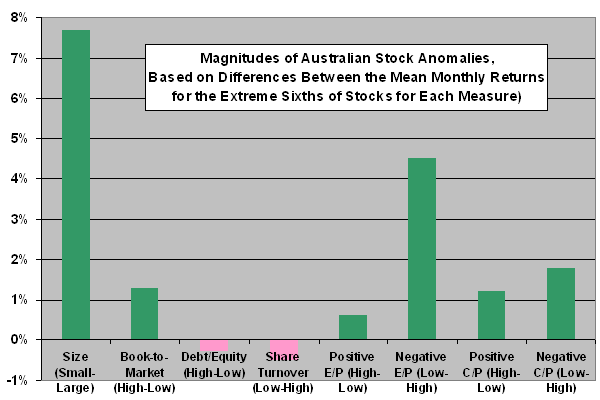Are anomalies observed with varying and changing levels of confidence among U.S. stocks, such as the size effect and the value premium, evident among stocks of other countries? In their recent paper entitled “Anomalies and Stock Returns: Australian Evidence”, Philip Gharghori, Ronald Lee and Madhu Veeraraghavan test for the existence among Australian stocks of a size effect, book-to-market effect, earnings-to-price (E/P) effect, cash flow-to-price (C/P) effect, leverage (debt-to-equity) effect and liquidity (share turnover) effect. Using stock price data for 1/92-12/05 and associated accounting data for 1/92-12/04, they conclude that:
- There are significant size, book-to-market, E/P and C/P effects among Australian stocks. (See the chart below.)
- There are no leverage and liquidity effects among Australian stocks.
- The Fama-French Three-Factor Model (returns for a stock are a function of its market beta, size and book-to-market ratio) outperforms the Capital Asset Pricing Model (returns for a stock are a function of its market beta) in explaining cross-sectional variation in stock returns. However, neither model works well in Australia.
The following chart, constructed from data in the paper, shows the magnitudes of the anomalies tested. Magnitudes are based on differences in mean monthly returns in excess of the 13-week Treasury bill yield between the stocks in the extreme sixths for the eight indicators. Indicator values are set in December of the year preceding measurement of stock returns. Size means market capitalization. The debt-to-equity ratio proxies for leverage. Share turnover proxies for liquidity. Positive (negative) E/P and C/P include only stocks with positive (negative) earnings and cash flows, respectively. The size effect and the E/P effect for stocks with negative earnings are remarkably large.

In summary, the Australian stock market offers several historical anomalies, most notably size and negative earnings-to-price, that investors/traders may be able to exploit.